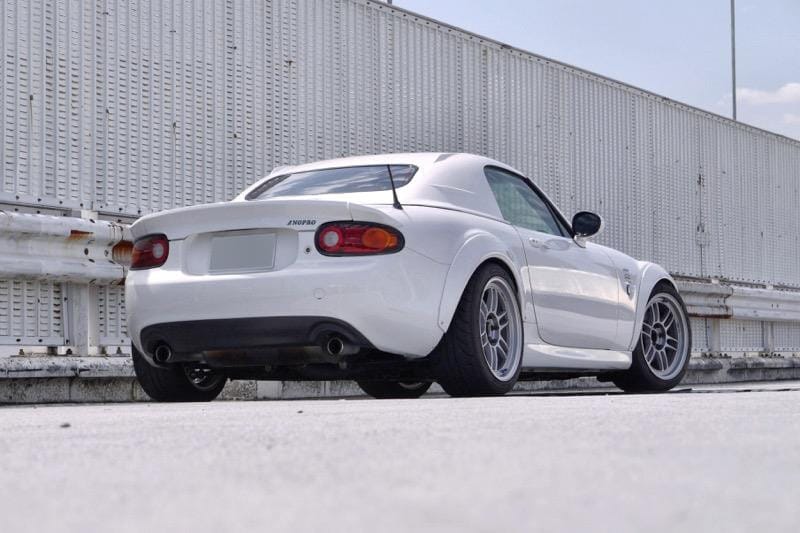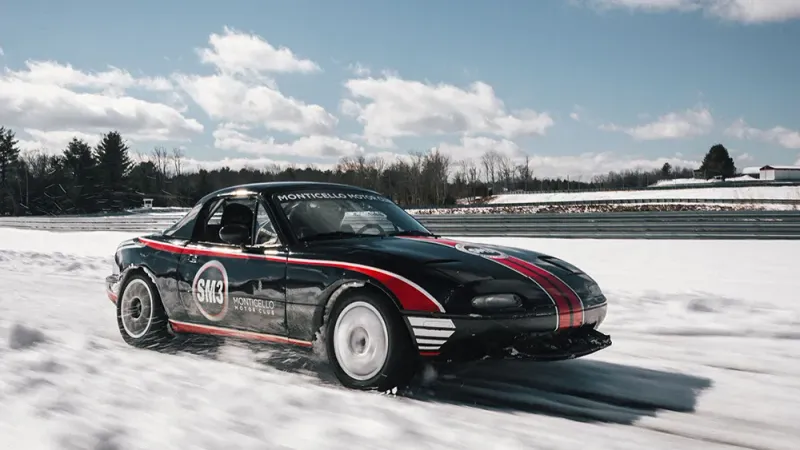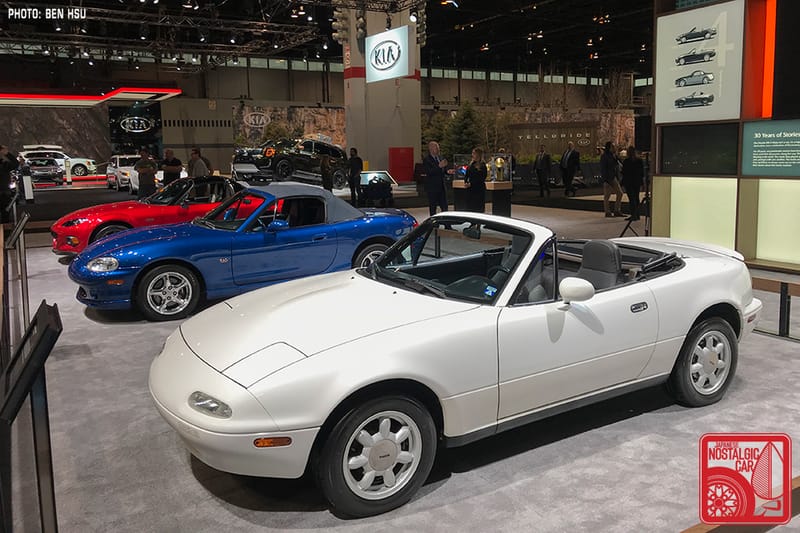All About Exocet Miatas
The Exomotive Exocet takes the guts of a 1990–2005 Miata—engine, transmission, diff, suspension, brakes—and drops them into a purpose-built exoskeletal frame with composite panels!

The Exomotive Exocet is basically a tubular, exoskeletal chassis that reuses the running gear from a 1990–2005 Mazda Miata (NA/NB). You lift the Miata’s “skateboard” , engine, transmission, differential with PPF, subframes, suspension, brakes, hubs, wiring , and drop it into a purpose-built frame with composite panels and minimal bodywork. You shed a ton of weight, sharpen the steering feel, and get a massive power-to-weight bump without reinventing the drivetrain. The latest chassis was reengineered with a finite-element approach: revised bulkheads, extra triangulation, gussets, and a stressed floor/trans tunnel. The upshot is a huge torsional stiffness gain over the previous generation and a platform that’s happy with everything from a stock 1.6 to an LS V8.
Models & Pricing
There are three trims: Base, Sport, and Race/Off-Road. The Base is street-oriented with mounts for 3-point belts. The Sport is the popular middle ground with harness provisions and a roll structure designed to exceed common club-racing guidelines. The Race adds a full cage and steel floors, while the Off-Road variant uses a widened and lengthened chassis for dirt duty. Current MSRP sits around $7,999 for Base, $8,299 for Sport, and $8,999 for Race or Off-Road. Overall dimensions are roughly 132 inches long, 68.4 inches wide, and 47 inches tall on the Miata’s 89.2-inch wheelbase, and finished weight usually falls between 1,400 and 1,700 pounds depending on options. Lead times have recently hovered around two months with a deposit up front, plus crating and freight on top.

Donor Selection Cheat-Sheet (NA/NB)
Early NA6 cars (1990–1993) use the 1.6L and make for the lightest, simplest base , great up to roughly 200 hp on stock driveline parts. NA8 (1994–1995) brings the 1.8L and, in many regions, fewer emissions headaches; Torsen LSDs show up here. Late NA8 (1996–1997) is OBD II, which is nice for diagnostics but can matter for inspections. NB1 (1999–2000) uses the BP-4W head with strong midrange and turbo-friendly compression. NB2 (2001–2005) adds VVT on the BP-Z3 for better midrange with tuning, but the VVT actuator is tall, so check hood and cowl clearances. The 2004–2005 Mazdaspeed donor technically works, but it’s usually more cost-effective to turbo a non-Mazdaspeed NB instead.

What You Reuse vs. What You Get
From the Miata you carry over the engine (1.6 or 1.8), transmission (5- or 6-speed, or even the auto), driveshaft, differential (open or Torsen), PPF, front and rear subframes, control arms, uprights, hubs (4×100), brakes, steering rack and column, wiring harness and switches, and associated hardware. The Exocet kit includes a powder-coat-ready chassis, composite nose/hood, rear tank cover, gauge cowl, pre-bent laser-cut aluminum floors and bulkheads, smoked polycarbonate side panels, and a hardware pack with fasteners, P-clips, edge trim, and Cunifer brake pipe. Sport adds harness and roll-structure upgrades; Race adds steel floors and a full cage. Options span gel-coat colors, headlight kits, wing mounts and wings, a wiring tray, fenders, and in-house powder coating.
The Build, General Outline
Start by stripping the Miata down to its “skateboard” , the complete PPF/engine/trans/diff assembly with both subframes, arms, uprights, brakes, and hubs still bolted together. This is the Exocet time-saver versus typical kit builds. Next, test-fit, seal, and rivet the pre-bent floors and bulkheads. With panels in, lower the Exocet chassis over the skateboard and bolt it up. Many builders reinstall the rear subframe brace, and there’s a simple crush-tube/bolt trick in the rear that you torque lightly to help wheel hop and tighten up handling. Then plumb brake, clutch, and fuel lines, set up pedals and steering, and install cooling, fuel system bits, and the parking brake. Lay out the Miata wiring as it came out of the donor, trim plastic channels, run the harness through the bulkheads, and tuck the ECU on a tray if you want a tidy bay. Seats and harnesses drop in last; Miata sliders can be reused if you drill the floor tube correctly. Finish with bodywork, mirrors, and lighting, add the optional windshield if you want one, get it aligned, shake it down, and handle registration.
Real-world builds usually land in the mid-1,500-pound range for a streetable turbo car without a full cage, while caged turbo demos tend to weigh around the low-1,600s with fluids and two seats. An LS-powered example can still sit under 1,700 pounds wet. That’s the Exocet’s party trick: Miata reliability with power-to-weight that embarrasses much pricier hardware.
Off-Road Exocet (What’s Different)
The Off-Road version isn’t just a lift kit. The chassis is wider by about eleven inches, the wheelbase stretches roughly three and a half inches, and ground clearance around fourteen inches is common when set up for a 31×10.5R15 tire. Final-drive options include deep gearing around 5.38:1 to suit those tall tires. Suspension packages range from rallycross-friendly travel to long-travel setups co-developed with Miata specialists, turning a humble donor into a legit trail toy.

Registration & Street Legality (U.S.)
Plan on using your state’s “custom” or “kit vehicle” path. Expect an inspection, VIN assignment (or reassignment), and paperwork that treats the car as a specially constructed vehicle. If your donor is OBD II (1996–2005), be ready to retain emissions equipment where required. It’s smart to look up your state’s rules before buying a donor so you don’t paint yourself into a compliance corner.
Where It Fits in Motorsports
Classing varies by region and sanctioning body. In autocross, many areas funnel tube-frame or kit builds into Modified categories or local specials; time-trial and track-day groups usually focus on safety gear and power-to-weight. The Sport and Race structures are built to exceed common club-racing cage guidelines, which tends to make tech a lot smoother. Always confirm with your local chapter before you show up to grid.
Power Paths (From Mild to Unhinged)
A stock or lightly tuned BP (100–150+ whp) keeps running costs low and the car playful. Turbo BP setups in the 200–300+ whp band are the sweet spot thanks to deep Miata aftermarket support and the Exocet’s light weight. If you want to go all-caps ridiculous, LS and other V8 swaps are supported with subframes and driveline kits; the chassis was laid out with big power in mind, and there are proven builds in the wild.
Budget Planning (Hard Numbers You Can Bank On)
Figure eight grand for the kit depending on trim, plus options for gel-coat color, lighting, wing mounts and wings, a wiring tray, fenders, and powder coat. Add a deposit to get in line, a crating fee, and freight that varies by distance and carrier. Your donor cost swings wildly based on condition and region; plan for bushings, bearings, fluids, brake lines, and “while you’re in there” refresh items so the finished car feels new, not recycled.
Build Tips
ABS donors work but add weight and complexity, so track-first builders often skip it. OBD II donors generally mean keeping emissions gear if your DMV requires it. NB2 VVT engines have a tall actuator , double-check hood and cowl clearance when laying out the intake and coil packs. For wheel hop, reinstall the rear subframe brace and do the light-torque crush-tube mod. Cooling is rarely a problem thanks to the open bodywork, but validate on your track and in your climate before downsizing radiators or fans.
If you want more grip and road-friendly visibility, there are bolt-on front and rear wing mounts designed for popular airfoils, along with DOT/SAE-style headlight options and tidy templates for tails and indicators. They’re quality-of-life upgrades that keep you wrenching less and lapping more.
Reusing Miata seats and sliders is common; just drill the floor tube cleanly and avoid crushing it when you bolt through. The Sport and Race harness bars make proper belt geometry easy , follow your belt maker’s wrap and angle guidance. Smoked polycarbonate side panels smooth airflow, keep debris off your elbows, and still show off the frame.




